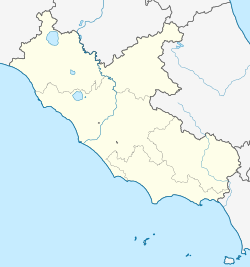world.wikisort.org - Italy
Lanuvio is a comune (municipality) in the Metropolitan City of Rome in the Italian region Latium, located about 30 kilometres (19 mi) southeast of Rome, on the Alban Hills.
Lanuvio | |
|---|---|
Comune | |
| Comune di Lanuvio | |
 | |
 Coat of arms | |
Location of Lanuvio  | |
 Lanuvio Location of Lanuvio in Italy  Lanuvio Lanuvio (Lazio) | |
| Coordinates: 41°41′N 12°42′E | |
| Country | Italy |
| Region | Latium |
| Metropolitan city | Rome (RM) |
| Frazioni | Campoleone, Bellavista, Colle Cavaliere, Casale della Corte, Malcavallo, Mantovano, Monte Giove, Pascolare, Pietrara, Sambuco, Stragonello |
| Government | |
| • Mayor | Luigi Galieti |
| Area | |
| • Total | 43.9 km2 (16.9 sq mi) |
| Elevation | 324 m (1,063 ft) |
| Population (1 January 2017)[2] | |
| • Total | 13,605 |
| • Density | 310/km2 (800/sq mi) |
| Demonym(s) | Civitani |
| Time zone | UTC+1 (CET) |
| • Summer (DST) | UTC+2 (CEST) |
| Postal code | 00075 |
| Dialing code | 06 |
| Patron saint | St. Peter the Apostle |
| Saint day | April 7 |
| Website | Official website |
Lanuvio borders the following municipalities: Aprilia, Ariccia, Genzano di Roma, Velletri.
History
In ancient times Lanuvium was an important town in the hinterland of Imperial Rome. The emperors Antoninus Pius and Commodus were born here, together with the condottiero Marcantonio Colonna. It decayed after the reign of Theodosius I (late 4th century AD), and was mostly abandoned due to the shutting down of its polytheistic sanctuaries.
It is mentioned again in the 11th century, when it was a seat of a Benedictine monastery. In the early 15th century it was acquired by the Colonna family, to whom it belonged until 1564.
On 17 February 1944, during World War II, it was bombed by sea and air by the Allied, and almost entirely destroyed.
Main sights
- Collegiate church
- Sanctuary of Madonna delle Grazie
- History center with walls, including four towers
- Temple of Juno Sospita
- Remains of the ancient Roman bridge Ponte Loreto
- Regional Park of the Castelli Romani
- Civic Museum of Lanuvio
Twin towns
 Centuripe, Italy
Centuripe, Italy
References
- "Superficie di Comuni Province e Regioni italiane al 9 ottobre 2011". Italian National Institute of Statistics. Retrieved 16 March 2019.
- All demographics and other statistics: Italian statistical institute Istat.
External links
![]() Media related to Lanuvio at Wikimedia Commons
Media related to Lanuvio at Wikimedia Commons
На других языках
- [en] Lanuvio
[es] Lanuvio
Lanuvio es una localidad italiana de la provincia de Roma, región de Lazio, con 12.581 habitantes.[2][ru] Ланувио
Лану́вио (итал. Lanuvio) — коммуна в Италии, располагается в провинции Рим (регион Лацио).Другой контент может иметь иную лицензию. Перед использованием материалов сайта WikiSort.org внимательно изучите правила лицензирования конкретных элементов наполнения сайта.
WikiSort.org - проект по пересортировке и дополнению контента Википедии